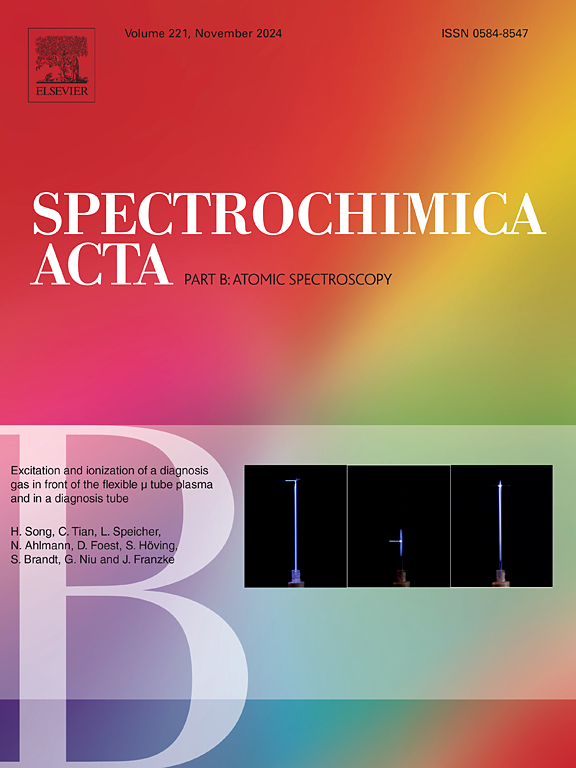A brief revision of the suspension-assisted direct solid analysis by TXRF spectrometry
IF 3.8
2区 化学
Q1 SPECTROSCOPY
引用次数: 0
Abstract
This brief revision compiles and reexamines the general strategy developed thus far for quantifying the elemental composition of solid materials using TXRF without employing acid chemical manipulation based on the previous suspension of the solid samples. This kind of analysis converts to the TXRF methodology in a green chemical analytical alternative with higher care for the environment and low analytical cost. The reviewed TXRF methodology is the sum of a Suspension Assisted (SA), which uses grinding, ultrasound, and surfactant addition, in conjunction with the Direct Solid Analysis (DSA), where the continuous agitation of suspension, internal standardisation and final deposition are made for the quantitative analysis by means TXRF. A general TXRF solid suspension analysis (SA/DSA-TXRF) protocol is proposed and applied to analyse a commercial sample of bentonite clay used for cosmetic applications as a typical sample example. Several critical questions related to the general process of suspension and deposition are discussed. Two crucial examples are the correct transfer of the suspended sample, which can lead to high uncertainties, and the impact of deposition morphology. Finally, a simple empirical procedure is presented using the analytical results obtained in the commercial bentonite sample to evaluate methodological, roughness, and instrumental uncertainties in the SA/DSA-TXRF proposed methodology.

悬浮液辅助直接固体分析TXRF光谱的简要修订
这一简短的修订汇编并重新审查了迄今为止使用TXRF定量固体材料元素组成的一般策略,而不使用基于先前固体样品悬浮液的酸性化学操作。这种分析转换为TXRF方法在绿色化学分析替代更高的关心环境和低分析成本。所回顾的TXRF方法是悬浮辅助(SA)的总和,它使用研磨,超声波和表面活性剂添加,结合直接固体分析(DSA),其中悬浮的连续搅拌,内部标准化和最终沉积是通过TXRF进行定量分析。提出了一种通用的TXRF固体悬浮分析(SA/DSA-TXRF)方案,并将其应用于分析化妆品用膨润土的商业样品作为典型样品。讨论了与悬浮和沉积一般过程有关的几个关键问题。两个关键的例子是悬浮样品的正确转移,这可能导致高不确定度,以及沉积形态的影响。最后,提出了一个简单的经验程序,使用在商业膨润土样品中获得的分析结果来评估SA/DSA-TXRF提出的方法的方法学,粗糙度和仪器不确定性。
本文章由计算机程序翻译,如有差异,请以英文原文为准。
求助全文
约1分钟内获得全文
求助全文
来源期刊
CiteScore
6.10
自引率
12.10%
发文量
173
审稿时长
81 days
期刊介绍:
Spectrochimica Acta Part B: Atomic Spectroscopy, is intended for the rapid publication of both original work and reviews in the following fields:
Atomic Emission (AES), Atomic Absorption (AAS) and Atomic Fluorescence (AFS) spectroscopy;
Mass Spectrometry (MS) for inorganic analysis covering Spark Source (SS-MS), Inductively Coupled Plasma (ICP-MS), Glow Discharge (GD-MS), and Secondary Ion Mass Spectrometry (SIMS).
Laser induced atomic spectroscopy for inorganic analysis, including non-linear optical laser spectroscopy, covering Laser Enhanced Ionization (LEI), Laser Induced Fluorescence (LIF), Resonance Ionization Spectroscopy (RIS) and Resonance Ionization Mass Spectrometry (RIMS); Laser Induced Breakdown Spectroscopy (LIBS); Cavity Ringdown Spectroscopy (CRDS), Laser Ablation Inductively Coupled Plasma Atomic Emission Spectroscopy (LA-ICP-AES) and Laser Ablation Inductively Coupled Plasma Mass Spectrometry (LA-ICP-MS).
X-ray spectrometry, X-ray Optics and Microanalysis, including X-ray fluorescence spectrometry (XRF) and related techniques, in particular Total-reflection X-ray Fluorescence Spectrometry (TXRF), and Synchrotron Radiation-excited Total reflection XRF (SR-TXRF).
Manuscripts dealing with (i) fundamentals, (ii) methodology development, (iii)instrumentation, and (iv) applications, can be submitted for publication.

 求助内容:
求助内容: 应助结果提醒方式:
应助结果提醒方式:


